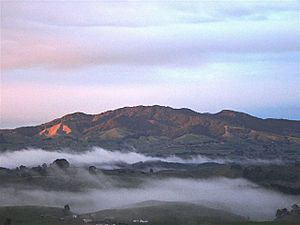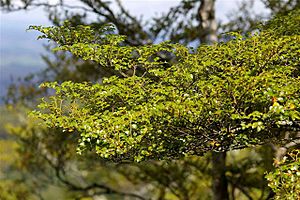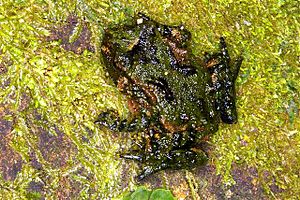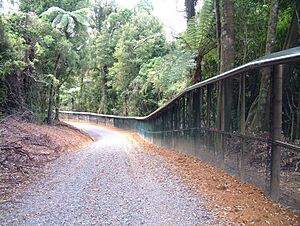Maungatautari facts for kids
Maungatautari is a special mountain, rural community, and natural area near Cambridge in the Waikato region of New Zealand's central North Island. Its name means "mountain of the upright stick" in Māori.
The Maungatautari Restoration Project is the largest nature restoration effort in New Zealand. This amazing project aims to remove all non-native animals like rats, stoats, and cats that harm local wildlife. The goal is to bring back endangered native plants and animals to Maungatautari. While they don't plan to remove all introduced birds, they do work to control harmful non-native wasps. The project includes both private land and a government-owned reserve. It's a community effort managed by the Maungatautari Ecological Island Trust.
Maungatautari Marae and Te Manawanui meeting house are located on the northern side of the mountain, looking over the Waikato River. This is an important meeting place for several Māori groups, including the Ngāti Korokī Kahukura, Ngāti Raukawa, and Waikato Tainui hapū (sub-tribes). It's a main marae for many families, including the Taute, Kara, Tupaea, Wirihana, Poka, and Tauroa whānau (families). Waniwani Pā is another traditional meeting ground for the Ngāti Korokī Kahukura hapū of Ngāti Waihoro.
Contents
Maungatautari: A Special Natural Area
Maungatautari is an old volcano that has been worn down over time. It was chosen for this big restoration project for many reasons. It has a wide variety of landscapes, from forests to rocky areas. Even though people have made some changes, many natural areas are still in good shape. The local communities were also very keen to help, and it was possible to build a special fence around the area.
Scientists were surprised by some of the discoveries made at Maungatautari. In April 2006, they found 100 silver beech trees. This was very exciting for plant experts! These trees, usually found in southern New Zealand, were not thought to be on Maungatautari. Researchers believe they have been there since the last ice age. Some of the biggest trees are hundreds of years old. The project's chief executive, Jim Mylchreest, said these trees were exciting not just by themselves, but also for the fungi and insects they might host that were also unexpected.
Amazing Animal Discoveries
In December 2004, eleven endangered Hochstetter's frogs were found living in a rocky area on Maungatautari. Scientists were already thinking about bringing these frogs back to the area, so finding a small group there naturally was a huge surprise and very exciting!
In March 2010, a dead Duvaucel's gecko was found in a mouse trap. This was the first time this type of gecko had been seen on mainland New Zealand in almost 100 years! This discovery likely means there's a small group of these geckos still living on Maungatautari.
The Plan to Restore Nature
Traditional ways of controlling pests, like poisons and traps, often don't work for long. So, the project leaders decided to build a special 47-kilometer-long pest-exclusion fence around 34 square kilometers of bush. This fence creates an "ecological island" where native animals can be safe. Once the area is clear of pests, many special native animals that are now rare or gone from the area will be brought back. These include the North Island brown kiwi, North Island kōkako, kakariki, and tuatara. Kaka birds already visit often and are likely to stay once the area is fully safe.
In November 2003, the Trust built two smaller fenced areas, one in the north and one in the south, covering 1.1 square kilometers. These areas were used to show that the fence would work and to test ways to remove pests. Pest removal started in September 2004. These smaller areas are now free of predators and were used to hold native species while the main fence was being built.
Building the main Xcluder fence began in July 2004. By September 2006, the entire 34 square kilometers was fenced off to keep out all pests. Then, the Trust started removing pests, first by dropping poison in November 2006 and again in December 2006. The poison, along with traps and hunting, helped get rid of brown rats, black rats, stoats, cats, weasels, ferrets, red deer, fallow deer, pigs, goats, possums, hedgehogs, rabbits, and hares. By 2007, the only pests left were mice. Poison was dropped a third time in September that year to try and get rid of them completely. This didn't work, so in 2011, the Trust changed its plan to focus on controlling mice rather than trying to remove every single one.
One big challenge for the fence designers was how to deal with streams. Water levels change, and the fence needed to handle both floating debris and allow fish to move freely. So, the Xcluder fence has an electronic system that warns the Trust if a watergate doesn't close properly. There have been other challenges, like storm damage in July 2007, but these were quickly fixed.
In July 2006, a viewing tower was built near a group of northern rata trees in the southern fenced area.
Bringing Back Native Species
Since the project began, native species have returned to Maungatautari either on their own or because they were brought back. In July 2007, scientists found a 300% increase in the number of native beetles in the southern fenced area!
In December 2005, a kiwi call was heard on Maungatautari for the first time in about a hundred years. In April 2007, radio signals suggested a kiwi might be sitting on an egg, but the nest was empty. However, in September 2007, two kiwi eggs were found! One wasn't fertile, but the other hatched in December 2007. This was the first kiwi chick known to hatch on Maungatautari in a century!
In June 2006, the Trust started bringing back species, beginning with a pair of critically endangered takahē birds. In April 2007, three types of endangered whitebait (native trout) were brought back. In May, kākā birds were placed in a special enclosure to help them get used to the area before being released. They quickly attracted wild kākā companions. In November of that year, seven kākā were released from the aviary.
On December 3, 2007, the Trust announced plans to bring back North Island robins, North Island kōkako, tuatara, popokatea (whiteheads), and hihi (stitchbirds) in 2008. In March 2009, 60 whiteheads (popokatea) and 59 hihi (stitchbirds) were released.
Native Species Living Here
Mammals
- New Zealand long-tailed bat (Chalinolobus tuberculatus)
Birds
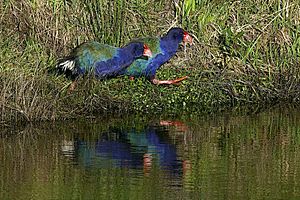
- Grey teal (Anas gracilis)
- Australasian shoveler (Anas rhynchotis)
- Grey duck (Anas superciliosa)
- New Zealand bellbird (korimako) (Anthornis melanura)
- North Island brown kiwi (kiwi) (Apteryx mantelli)
- Australasian bittern (Botaurus poiciloptilus)
- Shining cuckoo (Chrysococcyx lucidas)
- Australasian harrier (Circus approximans)
- White-faced heron (Egretta novaehollandiae)
- New Zealand falcon (kārearea) (Falco novaeseelandiae)
- Grey warbler (riroriro) (Gerygone igata)
- New Zealand kingfisher (Halcyon sancta)
- Wood pigeon (kererū) (Hemiphaga novaeseelandiae)
- Welcome swallow (Hirundo neoxena)
- Morepork (Ninox novaeseelandiae)
- Stitchbird (hihi) (Notiomystis cincta)
- North Island tomtit (Miromiro) (Petroica macrocephala toitoi)
- Whitehead (pōpokotea) (Mohoua albicilla)
- Black shag (Phalacrocorax carbo)
- Little pied cormorant (Phalacrocorax melanoleucos)
- New Zealand dabchick (Poliocephalus rufopectus)
- Takahē (Porphyrio hochstetteri)
- Pukeko (Porphyrio porphyrio)
- North Island fantail (Piwakawaka) (Rhipidura fulginosa placabilis)
- Paradise shelduck (Tadorna variegata)
- Silvereye (Zosterops lateralis)
- Tui (Prosthemadera novaeseelandiae)
- Kākā, (Nestor meridionalis)
Amphibians
- Hochstetter's frog (Leiopelma hochstetteri)
Reptiles
- Copper skink (Cyclodina aenea)
- Forest gecko (Hoplodactylus granulatus)
- Pacific gecko (Hoplodactylus pacifica)
- Auckland green gecko (Naultinus elegans elegans)
- Duvaucel's gecko (Hoplodactylus duvaucelli)
Fish
- New Zealand longfin eel (Anguilla dieffenbachii)
- Giant kokopu, (Galaxias argenteus)
- Banded kokopu, (Galaxias fasciatus)
- Shortjaw kokopu, (Galaxias postvectis)
Invertebrates
The Maungatautari Community
Quick facts for kids
Maungatautari
|
|
|---|---|
|
Village
|
|
| Country | New Zealand |
| Region | Waikato Region |
| District | Waipa District |
| Population
(2018 census)
|
|
| • Territorial | 822 |
| Time zone | UTC+12 (NZST) |
| • Summer (DST) | UTC+13 (NZDT) |
Who Lives in Maungatautari?
| Historical population | ||
|---|---|---|
| Year | Pop. | ±% p.a. |
| 2006 | 717 | — |
| 2013 | 750 | +0.64% |
| 2018 | 822 | +1.85% |
The Maungatautari area, which is 113 square kilometers, had a population of 822 people in the 2018 New Zealand census. This was an increase of 72 people (9.6%) since the 2013 census. There were 303 households. There were slightly more males than females. The average age was 39 years old. About 20% of the people were under 15 years old, and 12.4% were 65 or older.
Most people (89.1%) identified as European/Pākehā, while 12.0% identified as Māori. Other ethnicities included Pacific peoples (1.1%), Asian (3.3%), and other groups (1.5%). About 18.6% of the people were born outside New Zealand.
When asked about religion, 54.4% said they had no religion, and 36.5% were Christian. A small number of people followed other religions like Hindu and Buddhist.
Local Schools
Horahora School is a public primary school for both boys and girls. It was started in 1909 and currently has about 41 students. Maungatautari School was another primary school that opened in 1903 but closed in 2011.


